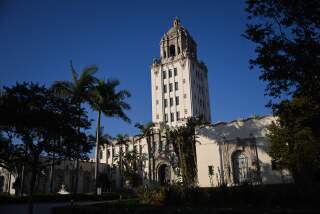Lurie Loses Lease on Key Marina Site : Real estate: Developer kept a grip on the prime property for nearly 25 years, failing to build a luxury hotel. County lost millions of dollars in revenues. : By
- Share via
Los Angeles County has terminated developer Abraham M. Lurie’s lease on the last piece of undeveloped waterfront property in Marina del Rey, ending what a top county official once described as “a great embarrassment.”
For almost 25 years, the county allowed the politically well-connected Lurie to maintain his grip on a prime parcel of public land without building the high-rise luxury hotel that he had promised.
While Lurie did nothing with the land, the county and its financially starved social programs, which are a recipient of marina revenues, lost millions of dollars in income from the property.
Instead, the county was content to receive $1,001 a month in rent, which sometimes went unpaid.
The county regained control of the land late last year after a federal judge ruled that Lurie and his Saudi Arabian business partner forfeited the lease in bankruptcy court.
“It’s ours,” county Beaches and Harbors Director Eric Bourdon said in a recent interview. “They just walked away from it.”
In doing so, Lurie and his partner also walked away from $1.3 million in deferred rent and interest owed to the financially strapped county.
County lease specialist Dennis Heitmann said there is no chance that the deferred rent and interest will be recovered.
Lurie confirmed that he lost the lease because of bankruptcy proceedings and blames the failure to construct a hotel on an inability to obtain financing.
The county has changed the locks on a gate to the weed-covered site, ending what critics have called the sweetest deal in the marina.
John Rizzo, president of the Marina Tenants Assn., accuses the county of “total mismanagement” by allowing Lurie to “pay practically nothing” on the property for 25 years.
County officials have acknowledged their disappointment at seeing the picturesque property remain unproductive.
“There is no doubt that parcel is the source of great embarrassment to us,” former Beaches and Harbors Director Ted Reed said in a 1989 interview. “We have not been able to accomplish what . . . was expected.”
Now, officials who oversee the marina have a chance to embark on a different course. With Los Angeles suffering from a glut of hotel rooms, Beaches and Harbors chief Bourdon does not expect that a hotel will be built on the land. So, officials are studying other residential and commercial uses for the 3.7-acre site, which has a sweeping view of the water and the city.
The county plans to begin soliciting development proposals in the next 90 to 120 days, although approval from the California Coastal Commission is needed before anything can be built.
County officials do not want to repeat the experience of the past quarter-century. Marina del Rey is one of the county’s only sources of no-strings-attached revenue to pay for public services.
The history of the property is one of repeated failures. Ironically, it begins and ends in bankruptcy.
Lurie acquired the lease on a large piece of undeveloped Marina property in November, 1968, after the initial leaseholder failed to develop it.
Five years later, the larger property was divided and a separate waterfront parcel was created at Via Marina and Tahiti Way. The county required Lurie to build a hotel and apartment complex on the site. The lease also required him to operate the premises “fully and continuously to the end that the public may enjoy maximum benefits and the county may obtain maximum revenue.”
But he did not move fast enough. A hard-nosed businessman with a penchant for litigation, Lurie became locked in a bitter fight with the Coastal Commission over its demands that he provide public access, including inexpensive hotel rooms for low-income guests.
Lurie fought back with legislation to pull the property out of the state’s coastal zone even though it lies along the water. The legislative end-run failed.
After spending what Bourdon calls “an ungodly amount of time fighting the Coastal Commission,” Lurie achieved a compromise.
In December, 1981, the commission gave him approval to build the nine-story, 300-room Marina Plaza Hotel on the water and to construct another high-rise hotel, the Marina Beach, a few blocks away.
There were 40 years remaining on the leases and Lurie demanded that the county extend them to 60 years so he could obtain financing.
In a 1982 letter to Supervisor Deane Dana, Lurie offered another argument for the lease extension. “Construction must be accelerated to achieve completion in time for the 1984 Olympics, in order to immediately maximize revenues to the county and to us,” he wrote.
By that time, one estimate put the county’s losses from Lurie’s failure to develop the property at $3.7 million since the mid-1970s.
Lurie had the clout to make his demands heard. He had become the biggest leaseholder in the marina, controlling hotels, apartments, offices, shops, restaurants and more than 1,100 boat slips.
Although a county consultant was skeptical that Lurie would obtain the financing to build both hotels, the supervisors in 1983 extended the leases to 60 years.
While construction proceeded on the Marina Beach Hotel, Lurie installed only concrete footings to preserve his permit for the Marina Plaza site. Beyond that, construction stopped for lack of financing.
Meanwhile, Lurie was allowed to continue paying $1,001 a month in rent on the Marina Plaza site. The county also allowed him to defer another $10,110 a month in rent plus interest until 15 years after he obtained permanent financing.
In hindsight, Lurie said recently, “not only wasn’t it feasible to build two hotels, but it turns out it wasn’t even feasible to build one.”
Burdened by debts from refinancing his marina holdings and losses at the Marina Beach Hotel, Lurie faced mounting financial problems. He had failed to pay more than $1 million in property taxes and was in default on some loans.
In 1989, Lurie won county approval to sell a 49.9% interest in his marina holdings to a secret group of foreign investors. The Times later identified the lead investor as billionaire Saudi Arabian businessman Abdul Aziz al Ibrahim, a brother-in-law of King Fahd.
At the time, Lurie pledged that the new partnership would pursue development of the hotel.
By 1990, county officials, faced with unfavorable publicity, began to take a much more aggressive stance, demanding that construction commence within a year.
Lurie and representatives of the Saudis responded by saying that the economic downturn made construction unfeasible.
But the county pressed on, filing a lawsuit in 1991 asking a Superior Court judge to declare the deadline to be reasonable.
But before the case could go to trial, the Saudis forced the Marina Plaza partnership into bankruptcy. A month later, in November, 1991, county officials say, Lurie stopped paying rent on the property.
U.S. Bankruptcy Judge Calvin K. Ashland initially gave Lurie and his partners 60 days to accept or reject the lease in bankruptcy. Ashland later ruled that the deadline should be extended.
The county appealed. U.S. District Judge A. Andrew Hauk ruled in October that Lurie and his partner had rejected the lease on the marina property, effectively surrendering control of the property.
While the appeal was being considered, the bankruptcy case involving the undeveloped marina land was dismissed by Ashland because Lurie and the Saudis failed to comply with requirements of federal bankruptcy law.
In deciding the appeal, Hauk called the bankruptcy proceeding “a travesty of justice” that delayed resolution of the county’s grievances.
“It is manifestly unfair to punish the county because of the debtor’s inability to make any decisions and take any action,” he said.
More to Read
Sign up for Essential California
The most important California stories and recommendations in your inbox every morning.
You may occasionally receive promotional content from the Los Angeles Times.










